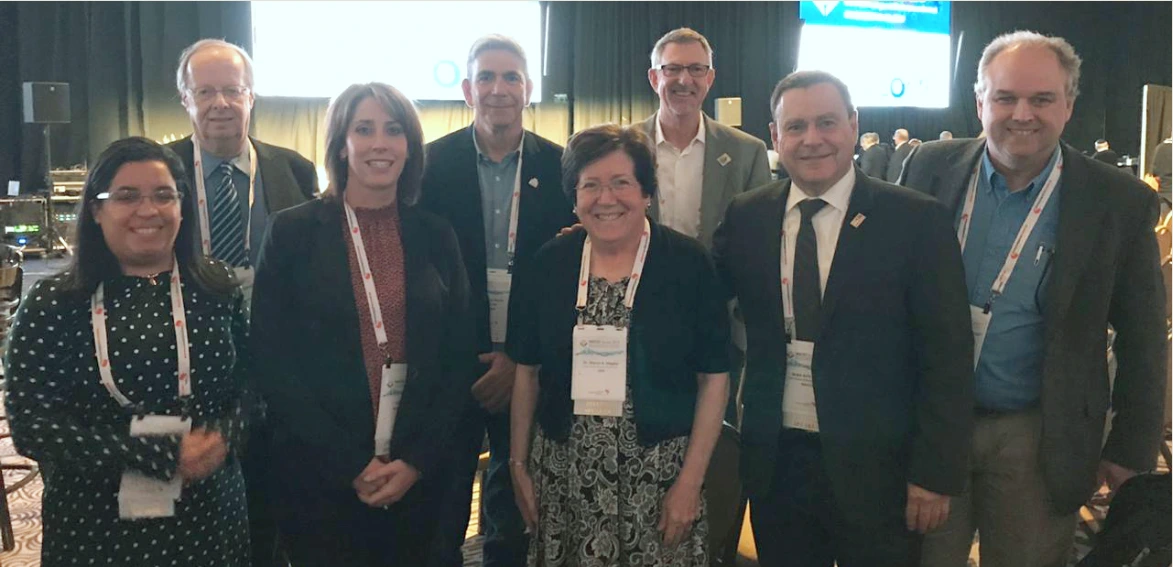
As an educator, I feel fortunate to have opportunities to share knowledge with individuals of different ages, backgrounds, and perspectives. Recently, I organized a panel for the biennial WATEC (Water Technology and Environmental Control) conference, which was held November 19-21, 2019 in Tel Aviv, Israel. The panel focused on implementing technology, specifically desalination technology, in a binational setting and brought together experts from the United States, Mexico, and Israel to discuss opportunities as well as constraints when working across borders. It was appropriate that the panel was slotted as a “Water and People” session at a conference that was laser-focused on technology. After all, working across borders requires intensive consultation and communication among the people involved.
Our panel assembled in the early afternoon of the first day of the conference. It was one of four concurrent Table Discussion panels designed to foster exchange of ideas and interaction with audience members, who were seated at a large rectangular table with microphones spread around. The Israeli panelists spoke about the feasibility study done by the World Bank and implementation efforts related to the Red Sea-Dead Sea project. The U.S. and Mexican panelists spoke about an ongoing study to look at desalination opportunities in the Sea of Cortez. This study is being conducted through an International Boundary and Water Commission facilitated process and is part of ongoing cooperative measures (see Minute 323). The order of presenters was as follows: Oded Fixler, Senior Deputy Director General, Ministry of Regional Cooperation, Israel; Dr. Doron Markel, Chief Scientist, KKL-JNF; Gregory Walch, General Counsel, Southern Nevada Water Authority; Chuck Cullom, Manager of Colorado River Programs, Central Arizona Project; Engineer Sergio Avila Ceceña, Executive Director, State Water Commission of Sonora; Andrea Alonso, Environmental Program Manager, Libra Ingenieros Civiles; and Lela Perkins, Client Services Manager, Black& Veatch. After the panelists provided their insights and overviews using Powerpoint slides, assembled into a single slide deck, I asked them to reflect on this question: What are the most important variables or factors that contribute to implementing technologies across borders?
Later in the day, at a session that summarized takeaways from the Table Discussions, I had the opportunity to share some insights from our panel. Interestingly, all agreed on the importance of food to building relationships and partnerships. A panelist succinctly stated, “Eat with your partners.” They agreed that having good functioning relationships is crucial. When working across national boundaries, it is critical to identify what is beneficial to both nations in order to identify win-win opportunities. It was also acknowledged that identifying such opportunities can be difficult and that relationships can have peaks and lows. Especially when working with neighbors with different cultures and languages, good communication, sincerity, and leadership will enable things to happen. Again, panelists came back to noting that eating together helps foster the friendships that then can facilitate the work required to forge formal agreements. The parallels between the two water-scarce regions of focus were clear to all. Desalinated seawater is an option for addressing the freshwater deficit, although there are the two main problems of energy requirements and brine disposal. It was noted that the Red Sea-Dead Sea project may be able to solve both problems by using elevation difference to generate hydropower and discharging the brine in a way that helps the Dead Sea, though there are questions about the scale of the desalination facilities and possible adverse impacts associated with changing Dead Sea water chemistry. With the driving factor, of course, being the need for water, trust is essential to identifying win-win opportunities.
On the second day of the conference, I participated in a Water and Politics panel, at which I spoke about the many layers of policy involved in coming to agreement on the Lower Colorado River Basin Drought Contingency Plan. At this panel, too, speakers noted that the process for complex deliberations is very important.
A great conference innovation this year was the addition of a third day dedicated to site visits. I went on the all-day field trip to Jerusalem waterworks, where presenters focused on how technology is being used to improve the safety and reliability of water delivery and wastewater treatment operations. It was exciting to visit the construction site for the fifth and very large water line to Jerusalem, where we donned hard hats and vests so that we could visit the tunnel boring and pipeline installation launching site.
The week-long visit was filled with many opportunities to share experiences, learn, and make connections with other experts. Although I woke up to a thunderstorm my first morning in Israel, they, like we in Arizona, had been experiencing a warm and dry Fall. So, the weather was great for being outdoors. Prior to the conference, I visited the Hula Valley Wetlands, which has such an interesting story behind it (https://www.iisd.org/pdf/2011/hula.pdf) and is an important bird flyway. On the day immediately prior to the start of the conference, a group from the United States and Mexico visited a pilot reverse osmosis facility, installed by a company that has recently been working in Arizona, at the regional Shafdan wastewater treatment plant. A great bonus was that we were in Tel Aviv for the reception celebrating the opening of the Arizona-Israel Trade and Investment Office. There we met up with other Arizonans, including several members of the Arizona Legislature (Representatives David Cook and Tony Rivero are pictured), along with representatives of the Arizona Commerce Authority and the Arizona business community.
I am grateful for a productive week of reinforcing and making professional connections, sharing experiences and lessons learned, and eating with my partners!


